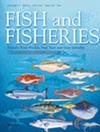Bottom‐Up Interactions in State‐Space Age‐Structured Models Using Mass‐Balance Dynamics
IF 6.1
1区 农林科学
Q1 FISHERIES
引用次数: 0
Abstract
Age‐structured models are used worldwide to regulate fisheries. These models typically ignore top‐down interactions (predation affecting natural mortality) and bottom‐up interactions (consumption affecting individual growth, reproduction, or survival), whereas multispecies catch‐at‐age models often incorporate top‐down but not bottom‐up interactions. While Ecopath‐with‐Ecosim (EwE) incorporates both top‐down and bottom‐up interactions along with age‐structured dynamics, it is not typically fitted to age‐composition data. We extend Ecostate (a state‐space version of EwE) to incorporate age‐structured dynamics while fitting to age‐structured data and use this to illustrate how to add bottom‐up interactions to age‐structured models. Specifically, we add age‐structured dynamics and likelihood components for age‐composition and weight‐at‐age data while estimating residual variation in larval survival (recruitment deviations) and consumption (weight‐at‐age deviations). As a demonstration, we fit the model to biomass and age‐composition data for two commercial species (Alaska pollock and sablefish) in the Gulf of Alaska, including population dynamics for their major prey, while not fitting weight‐at‐age data so that it can be used for out‐of‐sample evaluation of model performance. The model can be viewed as a multispecies age‐structured model (e.g., estimating adult mortality rates, survey catchability and selectivity, and recruitment variation) and as a mass‐balance ecosystem model (e.g., estimating trophic position and weight‐at‐age based on forage consumption). The predicted weight‐at‐age is weakly correlated with independent measurements for pollock and sablefish but was improved when we incorporated forage biomass indices. We recommend that age‐structured models routinely explore the link between prey consumption and resulting size‐at‐age, whether using coupled predator–prey dynamics or simplifications that treat prey abundance as fixed data.使用质量平衡动力学的状态-空间时代-结构模型中自下而上的相互作用
年龄结构模型在世界范围内用于管理渔业。这些模型通常忽略了自上而下的相互作用(捕食影响自然死亡率)和自下而上的相互作用(消耗影响个体生长、繁殖或生存),而多物种年龄捕获模型通常包含自上而下的相互作用,而不是自下而上的相互作用。虽然Ecopath - with - Ecosim (EwE)结合了自顶向下和自底向上的相互作用以及年龄结构动态,但它通常不适合年龄组成数据。我们扩展了Ecostate (EwE的状态空间版本),在适应年龄结构数据的同时,纳入了年龄结构动态,并用它来说明如何将自下而上的交互添加到年龄结构模型中。具体来说,我们在估算幼虫存活(招募偏差)和消耗(体重年龄偏差)的剩余变异时,为年龄组成和体重年龄数据添加了年龄结构动力学和可能性成分。作为演示,我们将模型拟合到阿拉斯加湾两种商业物种(阿拉斯加鳕鱼和貂鱼)的生物量和年龄组成数据中,包括其主要猎物的种群动态,而不拟合体重-年龄数据,以便它可以用于样本外评估模型性能。该模型可以看作是一个多物种年龄结构模型(例如,估计成年死亡率、调查可捕性和选择性以及招募变化)和一个质量平衡生态系统模型(例如,根据饲料消耗估计营养位置和年龄体重)。预测的年龄体重与鳕鱼和貂鱼的独立测量值相关性较弱,但当我们纳入饲料生物量指数时,预测的年龄体重得到了改善。我们建议年龄结构模型常规地探索猎物消耗和由此产生的年龄尺寸之间的联系,无论是使用耦合的捕食者-猎物动力学还是将猎物丰度视为固定数据的简化。
本文章由计算机程序翻译,如有差异,请以英文原文为准。
求助全文
约1分钟内获得全文
求助全文
来源期刊

Fish and Fisheries
农林科学-渔业
CiteScore
12.80
自引率
6.00%
发文量
83
期刊介绍:
Fish and Fisheries adopts a broad, interdisciplinary approach to the subject of fish biology and fisheries. It draws contributions in the form of major synoptic papers and syntheses or meta-analyses that lay out new approaches, re-examine existing findings, methods or theory, and discuss papers and commentaries from diverse areas. Focal areas include fish palaeontology, molecular biology and ecology, genetics, biochemistry, physiology, ecology, behaviour, evolutionary studies, conservation, assessment, population dynamics, mathematical modelling, ecosystem analysis and the social, economic and policy aspects of fisheries where they are grounded in a scientific approach. A paper in Fish and Fisheries must draw upon all key elements of the existing literature on a topic, normally have a broad geographic and/or taxonomic scope, and provide general points which make it compelling to a wide range of readers whatever their geographical location. So, in short, we aim to publish articles that make syntheses of old or synoptic, long-term or spatially widespread data, introduce or consolidate fresh concepts or theory, or, in the Ghoti section, briefly justify preliminary, new synoptic ideas. Please note that authors of submissions not meeting this mandate will be directed to the appropriate primary literature.
 求助内容:
求助内容: 应助结果提醒方式:
应助结果提醒方式:


